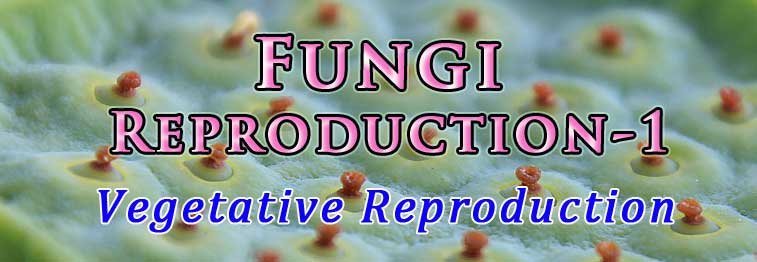Vegetative Reproduction in Fungi
Fungi reproduce by vegetative, asexual and sexual methods. This post describes different types of Vegetative Reproduction in Fungi. Vegetative reproduction helps to increase the number of individuals in the population.
Vegetative Reproduction in Fungi
Ø Vegetative reproduction in fungi occurs by:
(1). Fragmentation
(2). Fission
(3). Bud fission
(4). Budding
(5). Gemmae
(6). Sclerotia
(7). Rhizomorphs
(8). Mycelial cords
(1). Fragmentation
Ø Mycelium gets fragmented into small fragments, each of which is able to develop into new individual
Ø Fragmentation is common in filamentous fungi such as Rhizopus and Aspergillus
(2). Fission
Ø Fission occurs in unicellular fungi such as Yeasts
Ø Mature cells divided mitotically into two and the two daughter cells separates and give rise to two individuals

(3). Bud fission
Ø It is a modified type of fission
Ø In bud fission cross wall are developed near the base of the bud to separate bud from mother cell
Ø Here only the buds undergo fission not the mother cell
(4). Budding
Ø Bud like growth emerges out from the mature cells
Ø Budding is commonly occurs in unicellular forms such as Yeast
Ø Budding of Yeast may be of different types:
(a). Multilateral budding: buds arise at any point on the mother cell, but never again at the same site
(b). Uni-polar budding: budding repeated at same site on mother cell surface
(c). Bi-polar budding: budding restricted to both poles of the cell
(d). Monopolar budding: buds originate at only one pole of the mother cell
(5). Formation of Gemmae
Ø Gemmae are specialized thick walled aggregation of chlamydospres like structures
Ø They are formed in un-favourable conditions (Example: Saprolegnia)
(6). Sclerotia
Ø Sclerotia (sclerotium) are pseudo-parencymatous mycelial aggregations
Learn more: Mycelial aggregations in fungi
Ø Sclerotia can also overcome unfavourable conditions
Ø Sclerotia can survive in the substratum (Eg. soil) for many years
Ø Sclerotia are commonly produced by plant pathogenic fungi
Ø The size and shape of sclerotia varies in different fungal groups
(7). Rhizomorphs
Ø They are root like mycelial aggregations found in some fungi
Ø They are pseudo-parenchymatous hyphal modifications
Ø They can also overcome unfavourable conditions
Ø Rhizomorphs have high penetration capacity than individual hyphae and hence they have more pathogenic potential
Ø Bits of rhizomorps that survive in the soil, can act as inoculum for the next round of infection during the onset of favourable conditions
(8). Mycelial cords
Ø They are also thread like mycelial aggregations
Ø Formed by the more or less parallel aggregation of hyphal strand in some fungi
Ø Mycelial cords can also acts as bidirectional transport channels for nutrients
Ø Mycelial cords also helps the fungi to establish and colonize new areas from a food rich area
Learn more: Asexual reproduction in Fungi
Learn more: Sexual reproduction in Fungi
| You may also like... | ||
|---|---|---|
| NOTES | QUESTION BANK | COMPETITIVE EXAMS. |
| PPTs | UNIVERSITY EXAMS | DIFFERENCE BETWEEN.. |
| MCQs | PLUS ONE BIOLOGY | NEWS & JOBS |
| MOCK TESTS | PLUS TWO BIOLOGY | PRACTICAL |
You may also like…
